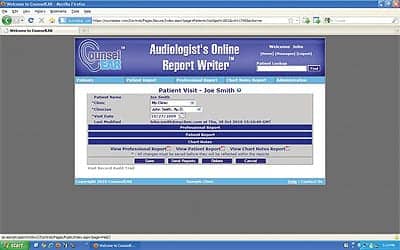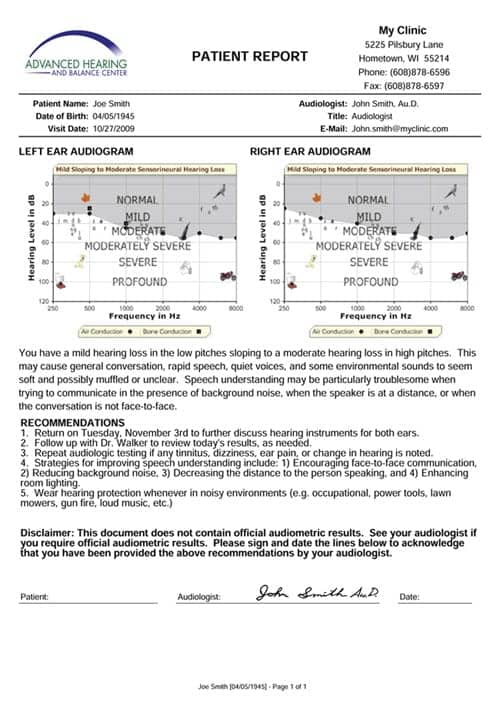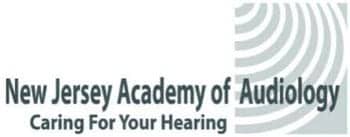An online system for gathering patient data and generating easy-to-read professional-looking reports for patients and their physicians increases the effectiveness of your patient counseling and marketing efforts.
Providing exceptional diagnostic and (re)habilitative services is the cornerstone of any hearing care practice. Unfortunately, while well-intentioned dispensing professionals may deliver exhaustive information—detailing all aspects of the results, recommendations, and amplification options—little attention is paid to helping the patient retain important information.
A disconnect frequently exists whereby the dispensing professional feels confident that effective counseling was delivered despite the fact that the patient and their family/caregivers remain poorly informed. Margolis1 showed that, in a typical hearing care counseling session, patients recall only approximately 25% of information correctly. Margolis also reported that approximately 25% of the information is remembered incorrectly and 50% is forgotten completely. These observations were found to be independent of the severity of the diagnosis as well as the patient’s level of education.
Too often, a lack of understanding regarding effective counseling techniques results in poor patient recall and compliance. These techniques inevitably lead to patient dissatisfaction and can hinder optimal treatment outcomes. Audiologists and other dispensing professionals must move beyond verbal-only, didactic counseling, and embrace a more comprehensive approach of patient-centric counseling that addresses each individual’s learning preferences, as well as hearing health care needs.
CounselEAR is a new online tool (Figure 1) that enables dispensing professionals to rapidly create customized counseling summaries, official audiologic reports, and chart notes. In addition, CounselEAR is compatible with NOAH and several office management systems (OMS), allowing seamless transfer of data with only a couple of clicks. The entire system is designed to improve what patients remember—and make clinics more efficient—anytime, anywhere online.
The following details five common problems and solutions in day-to-day hearing care using an online hearing care practice system developed by CounselEAR.
#1. Patient Understanding of Recommendations for Appropriate Follow-through

|
| FIGURE 1. The CounselEAR Report Writer screen. |
Problem: As shown by Margolis,1 patents remember only about half of the information given in a counseling session. Of that, approximately half is remembered incorrectly. That means, in a typical counseling session, only 25% of the information is remembered correctly! Therefore, studies recommend the best way to improve recall is to provide patients with customized education materials that are illustrated and easy to read.
Solution: A customized report, such as the Patient Report (Figure 2), gives hearing care providers the ability to create patient-specific summaries, including easy-to-read descriptions of the hearing loss, as well as customized recommendations and comments. The report is designed to enhance what patients are told in the counseling session, and increases the likelihood that they will follow through with recommendations—and it can be generated in less than 20 seconds.
#2. Increasing Office/Clinic Efficiency
Problem: Typing official audiologic reports can be time-consuming and, ultimately, expensive. Handwritten audiograms and reports are often difficult to read, prone to errors, and often unprofessional in appearance.
Solution: The Professional Report (Figure 3) makes the writing of official audiologic reports quick, easy, and more accurate. When the audiometric data is entered during or following the testing session, it takes only minutes to finalize the remainder of the report. Voice Recognition Software and custom templates can be used to speed you through to completion with little need for typing.

|
| FIGURE 2. Patient Report that goes home with the patient. |

|
| FIGURE 3. The Professional Report that is sent to the patient’s physician. |
Your referral database can be uploaded to CounselEAR, enabling you to create fax cover sheets, cover letters, and medical clearance forms with only a single click. Finally, you have the option of faxing or e-mailing your reports directly from CounselEAR, saving you time and money.
#3. NOAH-related Issues
Problem: Entering audiometric data into NOAH can be slow and errors are easily made. Additionally, most NOAH-compatible audiometers provide only basic report writing capabilities that cannot be customized by the clinician.
Solution: CounselEAR’s NOAH module, Synergy, enables audiologists to transfer data seamlessly between CounselEAR and NOAH. After the audiologic evaluation is complete, data can be transferred with only a couple of clicks. Synergy eliminates data-entry inaccuracies and allows the dispensing professional to rapidly provide hearing instrument demonstrations without making the patient wait. It also helps to increase office efficiency and gives patients an opportunity to immediately experience the benefits of amplification.
#4. Compatibility-related Issues
Problem: Entering patient data into multiple systems takes a great deal of time and effort for both you and your staff. As a result, many clinics do not take full advantage of their office management software.
Solution: CounselEAR’s NOAH module, Synergy, gives you the option of transferring audiometric results between NOAH and your OMS database. In addition to saving time and effort, this enables you to take better advantage of the marketing and patient management features that CounselEAR is compatible with.
#5. Enhanced Marketing…
To your patients. Better-informed patients are better patients. Yet, patients routinely receive only a quick verbal summary of their audiologic results. Even when a spouse, family member, or caregiver accompanies the patient, their decision regarding amplification is often delayed until they are able to “think it over.” These tested-but-not-sold patients are then left to decide based on what they remember about the counseling session. Consequently, many never return.
With the Patient Report (Figure 2), tested-but-not-sold patients are sent away with a colorful layman’s description of their hearing loss, as well as recommendations that are specifically tailored to their needs. Collectively, this enhances the professional image of the clinic and increases the likelihood that the patient will follow through with the recommendations.
To referring physicians. Developing and maintaining a strong physician referral base is a cost-efficient way of ensuring a continual flow of new patients. Although audiologic reports are our primary point of contact with many (or perhaps most) physicians, dispensing professionals rarely use these reports as a means of presenting their practices as centers of excellence. Rather, we often choose to provide brief handwritten summaries that are difficult to read.
With the Professional Report (Figure 3), dispensing professionals can use reports as a method of promoting their clinic and their services. The clinic’s excellence is easily reinforced with each and every referral, reminding physicians that their patients are in good hands.
For your promotions. Effective use of marketing dollars is a primary objective for all promotional campaigns. However, the prospect of culling specific target groups from an entire patient database can be daunting, particularly when the goal is to direct the advertisement toward patients within a certain type, degree, and configuration of hearing loss.
With CounselEAR, clinicians can utilize the Patient Activity feature to quickly identify a target group based on a variety of categories, including hearing loss and test date. CounselEAR saves time and money, and makes marketing efforts more efficient and effective.
Reference
- Margolis RH. Informational Counseling in Health Professionals: What Do Patients Remember? Available at: www.audiologyincorporated.com. Accessed October 20, 2010.
Citation for this article:
Urban B. Five ways an online report writer helps dispensing offices. Hearing Review. 2010;17(12):34-36.






